|
This page is about my third chicken flock (aka third generation) which I got in 2021. |

|
This page is about my third chicken flock (aka third generation) which I got in 2021. |

|
My third generation chicks were shipped from Meyer Hatchery on April 12, 2021. I consider that their birthday. All nine arrived safely in the mail (I picked them up at the post office) on April 14, 2021. The next day, at three days of age, I took photos of each of them. I would love to tell you what breed each of them is but that is hard to tell when they are so young.
In the below picture, the green stuff is GroGel Plus B super hydrating gel plus nutrition for chicks. They drink a solution of water and Vital Pack which has vitamins and electrolytes. 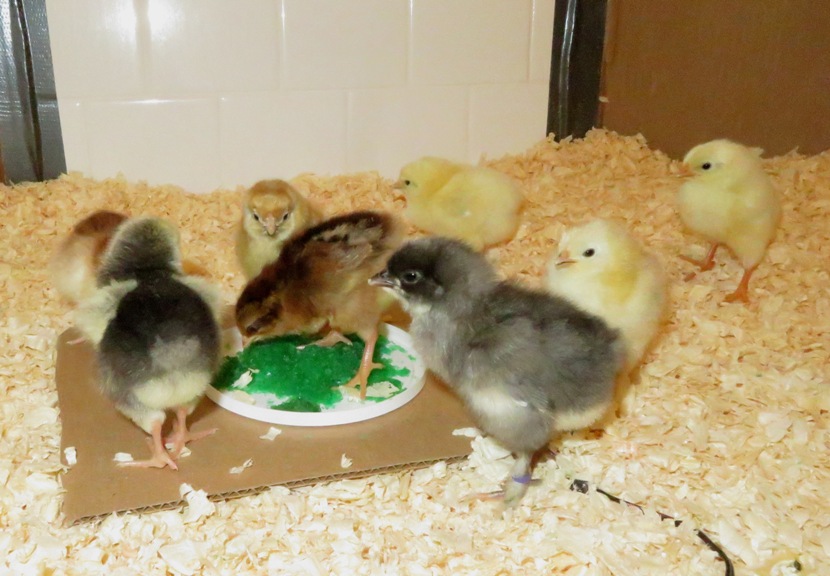
Here's every member of the flock on their first day with me. Notice how the first three look so similar. Their apearances diverged as they aged. The naming algorithm that Norma and I chose for this flock is similar to the previous generations in that the first letter of the name of the chicken must be the same as the first letter of their breed. But in addition to that, we decided that their name must be that of a female country music singer. Wynonna was the name for one of the breeds that starts with a 'W' but we couldn't think of another female country music singer whose name starts with 'W' unless we used last names, in which case "Wynette" would be acceptable. But Sara gave us a couple of suggestions: Wanda Jackson and Olivia Rose. Norma and I were not familiar with these singers but we confirmed that they were indeed famous so we went with them. Sara is very good at helping us come up with names.  |

|
I really like the gradual change in coloration of the chick on the far right. It reminds me of a Siamese cat.
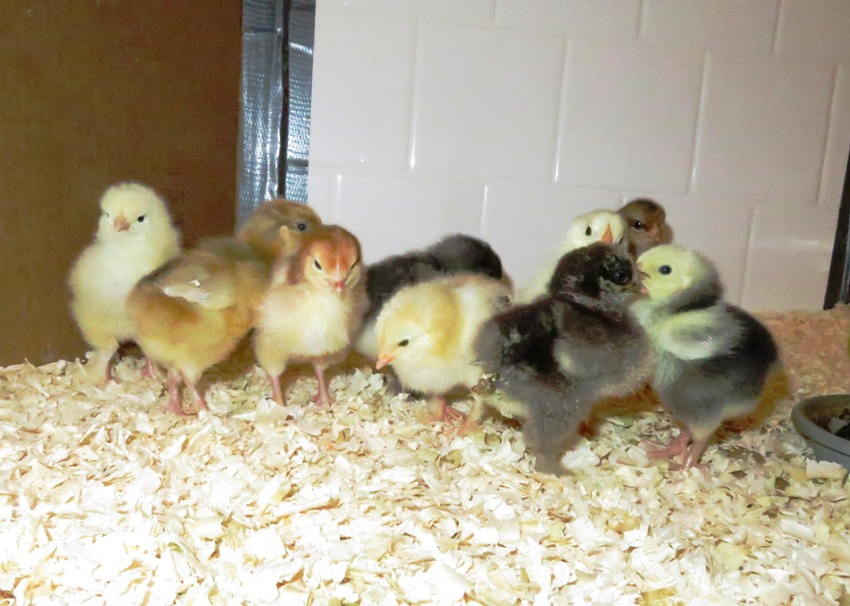
The real feathers (not just down) are starting to show on this one. 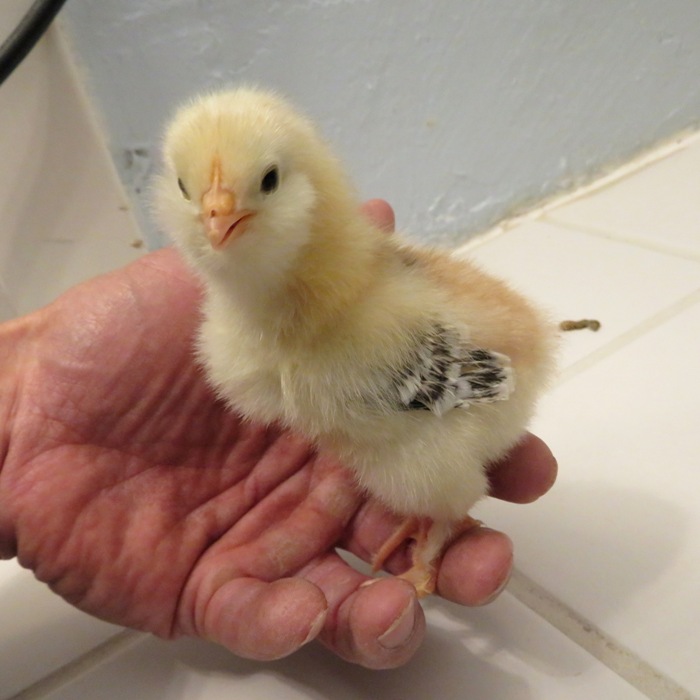
They don't like to be caught but once they are caught, they are content to stand on my hand...maybe because it is warm. 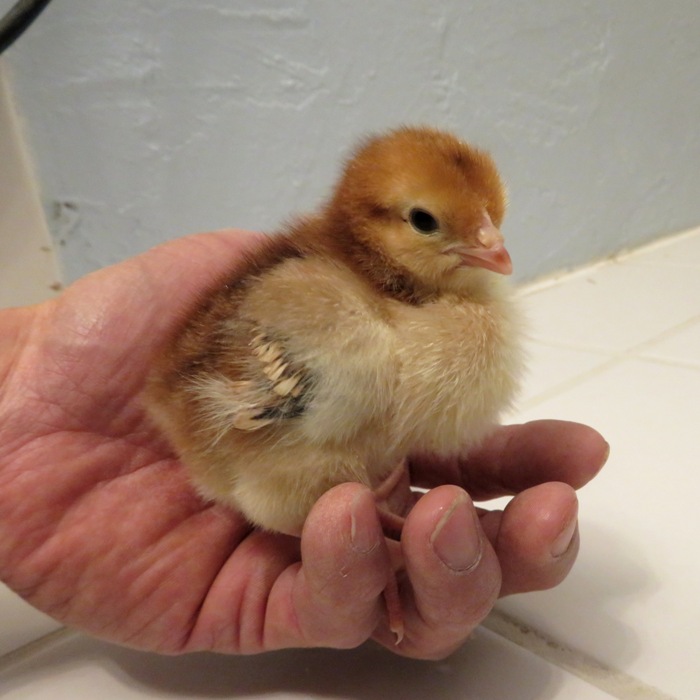
This one calls out to the flock. She doesn't like being separated. 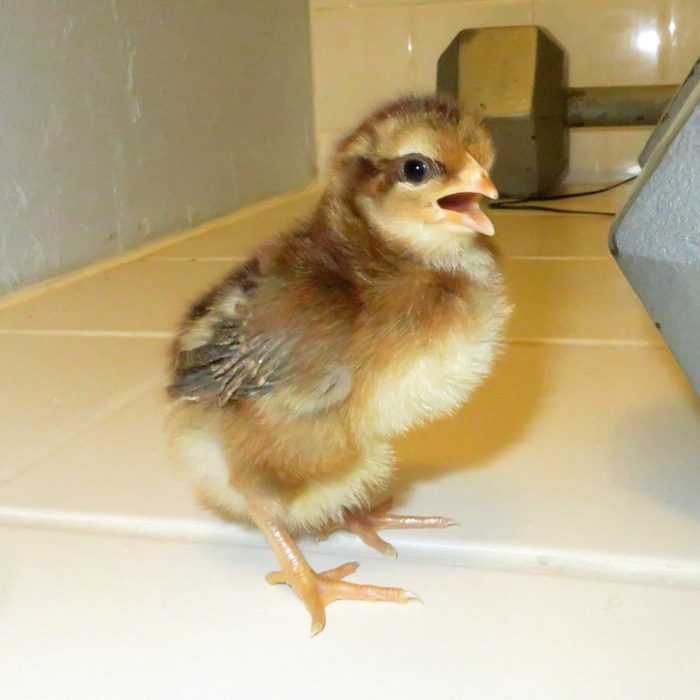
A daily routine for chicks this young is to check their asses for pasty butt. That's when their poop hardens around their anus. If it isn't cleared, it can be fatal. They eventually outgrow it. The smaller ones are more likely to have this problem.  |

 |

|
Their feet are now big enough to grab onto my finger. This one came marked with a rubber band around its leg. So that means it is an Olive Egger because that is what the receipt said. Her name is Olivia. The rubber band has been removed.

 |

|
The feathers are coming in quite nicely on this chick. Her tail feathers are even coming in.
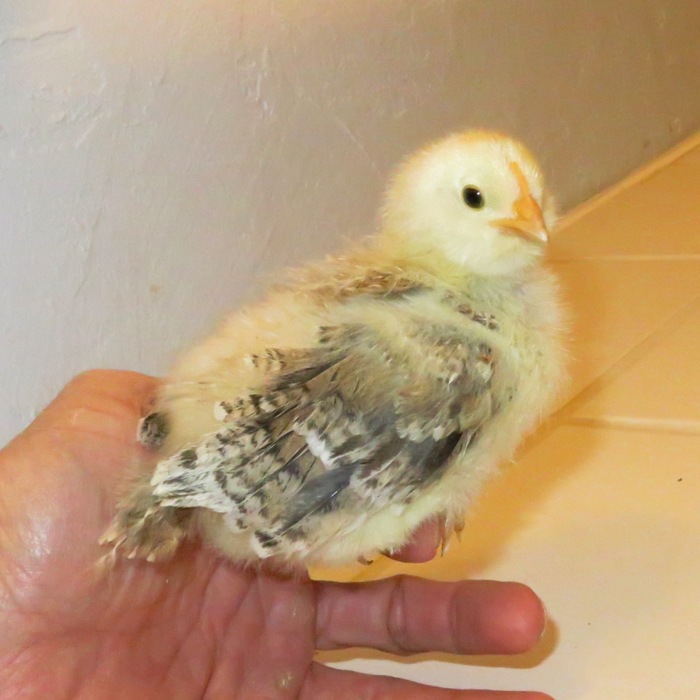
 |

|
First in flight on May 1, 2021. "Flying" might be stretching it a bit but she didn't get to the top of her feed jar by just jumping. The others are looking rather impressed by her feat.
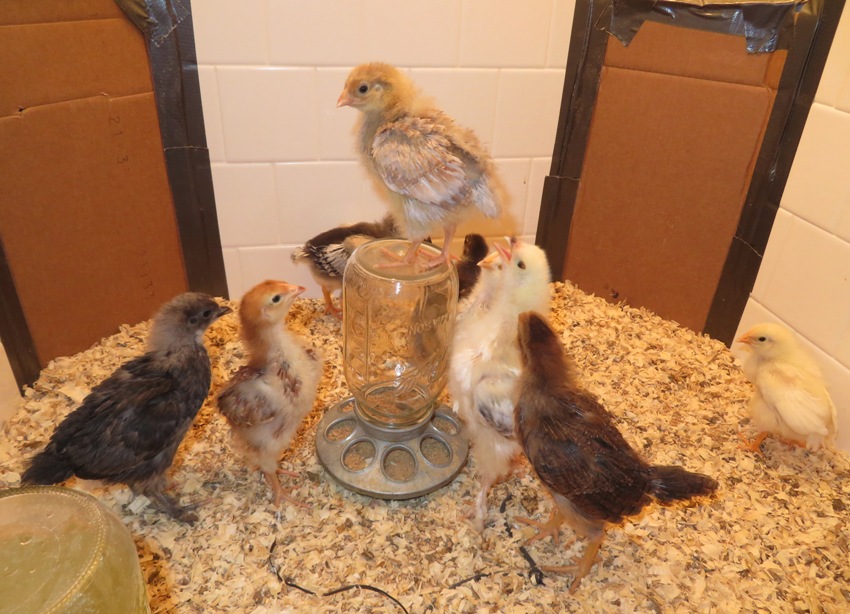
Now they are definitely in the awkward-looking stage of development. I increased the size of their space and stopped checking them for pasty butt. Now that they have some real feathers and are getting stronger, some are testing out their flying abilities. Yesterday, the smallest one (Wanda), who appears on the far right in the picture above, flew to the top of the wall that keeps them confined (about two feet high).  |

|
Oliva, an Olive Egger. Sometimes this breed has feathers on their legs and sometimes they don't.

I think this is Barbara, a Blue Laced Red Wyandotte or Shania, a Salmon Faverolle. 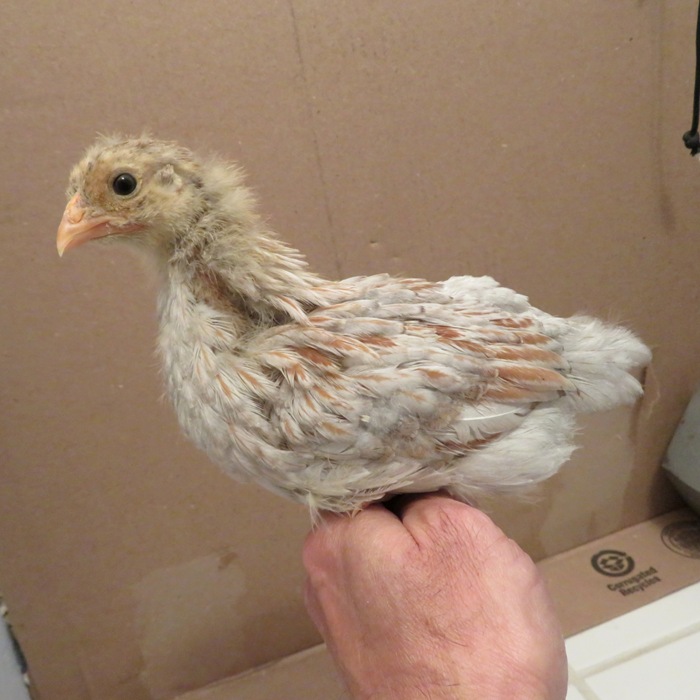
The small white one on the left is the runt. It is Wanda, a White Leghorn. Unlike that breed's stereotype, she is friendly. She is Viviana's favorite and a good flyer. 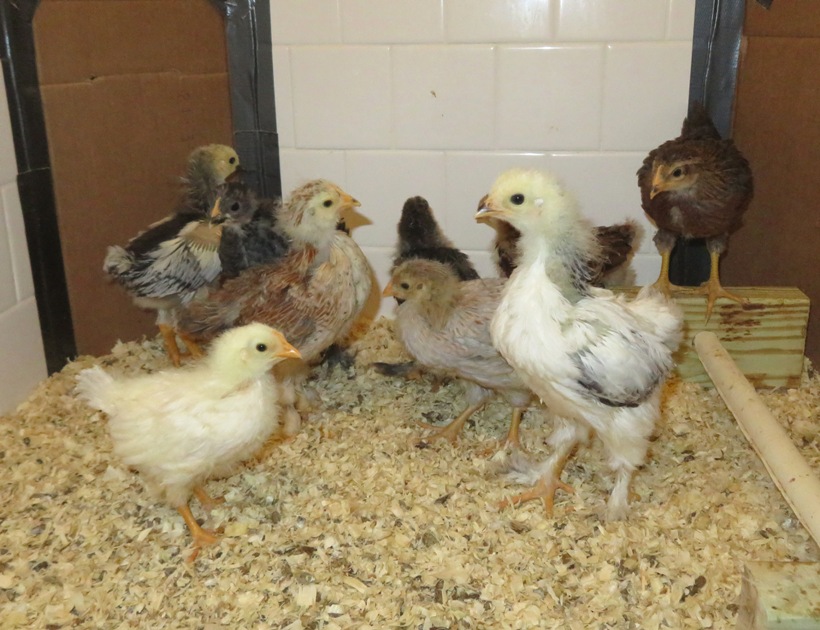
 |

|
They are old enough now to identify their breeds with some certainty.
Their plumage is filling in nicely and they are looking more like small adults than chicks. It won't be long before I move them to the coop. 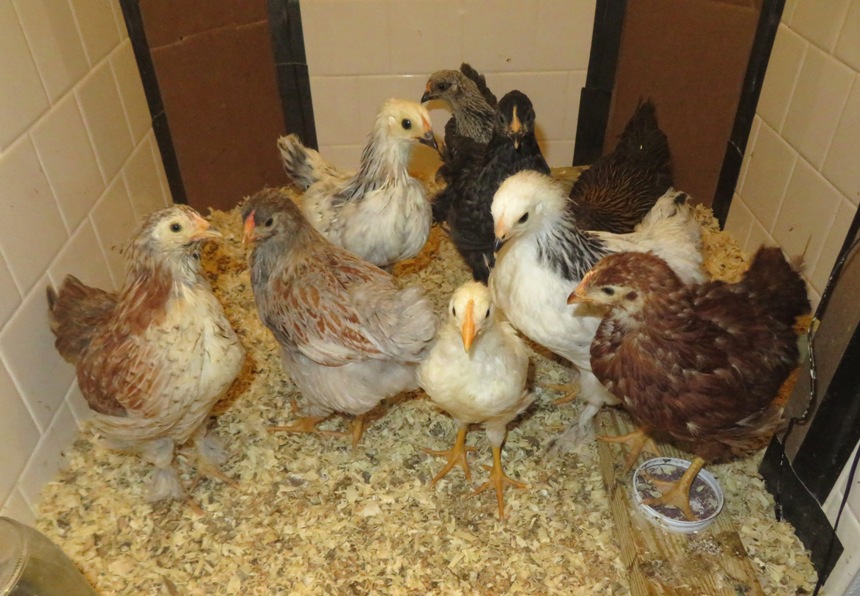
 |

|
These are the last photos you'll see of the girls inside the house. These pictures were taken May 30, 2021. As newborns, the temperature of their environment should be 95 degrees. Every week, that number can be decreased five degrees. So after 49 days (seven weeks), they are ready for 95 - (7 x 5) = 60 degrees.
A bit of trivia is that a former co-worker of mine, Pete J., was in a band, and Crystal Gayle opened for them. His band never amounted to much (I don't remember their name) while Crystal Gayle became a superstar. This Crystal looks very much like Loretta, a Light Brahma. The difference is that Crystal doesn't have feathers on her legs. 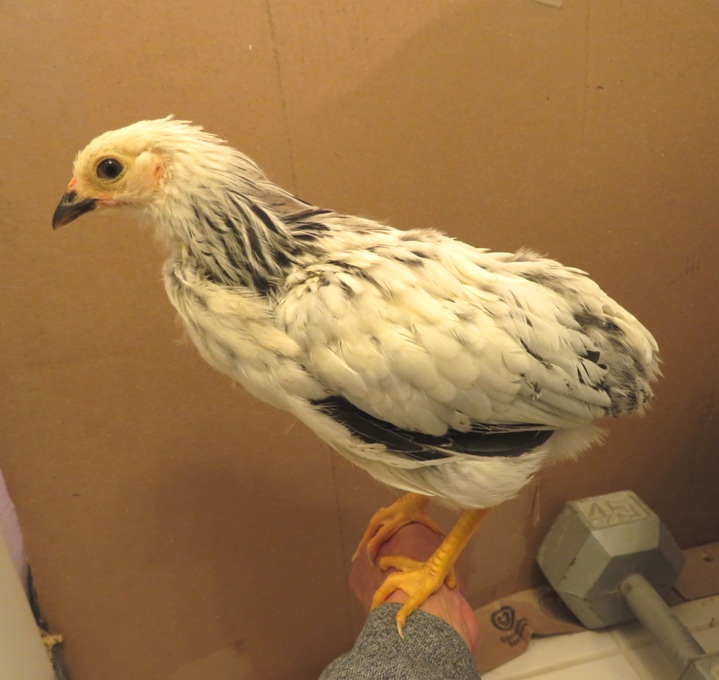
 |

|
For the third generation, Norma and I decided to name the girls after country western singers. Again, the first letter of the name is the same as the first letter of the breed.
BarbaraDate of birth: April 12, 2021Breed: Blue Laced Red Wyandotte Eggs/Year average: 4-6 light brown eggs each week in season [21] Description: Developed in New York State and Wisconsin in the late 19th century and come in many colors. The Blue Laced Red Wyandotte is a buff color with blue lacing - an unusual color in chickendom. However, the blue color in chickens does not breed true, and you may receive blue, black, or splash chicks. Wyandottes make a good dual purpose breed. Wyandottes are very nice birds and are an excellent family friendly breed. The color blue does not breed true. The chicks hatched from blue parents can be blue, black, or splash. Average mature weight of hens: 6.5 pounds [21]. 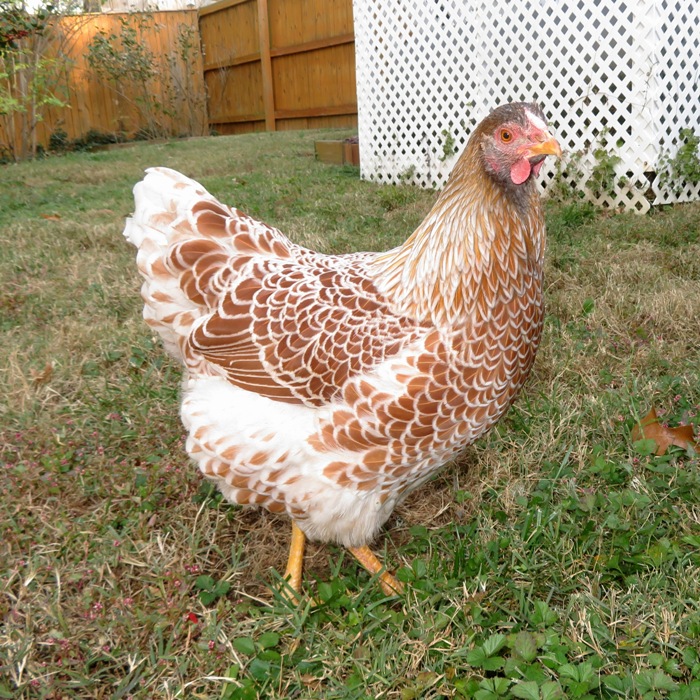
CrystalDate of birth: April 12, 2021Breed: Columbian Wyandotte Eggs/Year average: 4-6 brown eggs per week [21] Description: First introduced at the Columbian Exposition (better known as the World's Fair held in Chicago) in 1893, hence the name they now hold. These birds are truly in a class of their own with the Columbian pattern on their necks and tail feathers that contrast with their white bodies. Definitely a must for your flock! Columbian Wyandotte chickens are a docile breed that may occasionally go broody. They have clean legs and a rose comb. Wyandottes are also considered a sustainable heritage dual-purpose breed, so they are a great choice for your homestead. Average mature weight of hens: 6.5 pounds [21]. 
DollyDate of birth: April 12, 2021Breed: Dark Brahma Eggs/Year average: Brown eggs laid mainly from October to May or an average of 3-5 per week [21] Description: Dark Brahma Chickens are known for their large size, feathered feet, and winter laying abilities. Introduced to the United States in the 1850's, these chickens helped to ignite a nationwide love for poultry. Brahmas are best suited for northern climates. Brahmas are slow to mature, make dedicated mothers, and are also excellent for roasting due to their very large size. Average mature weight of hens: 9.5 pounds [21]. 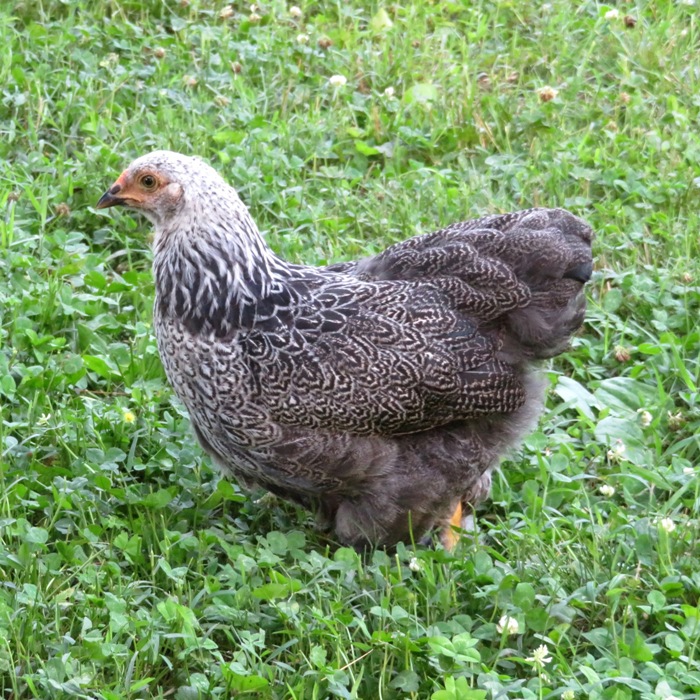
LorettaDate of birth: April 12, 2021Breed: Light Brahma Eggs/Year average: 3-5 brown eggs a week [13] Description: Introduced to the United States in the mid 19th century from China and imported to England in 1840. The American Poultry fanciers refined the original stock into a large stately breed. They make a good dual-purpose breed and are known for good winter production. Brahmas do good in confinement but even better if they have access to an outdoor run. They are mellow, quite hardy, have feathered feet, and make good pets. They thrive in northern climates. Light Brahma hens begin laying around 20 weeks and males are ready for processing at 24 weeks. Average mature weight of hens: 9.5 pounds [21]. 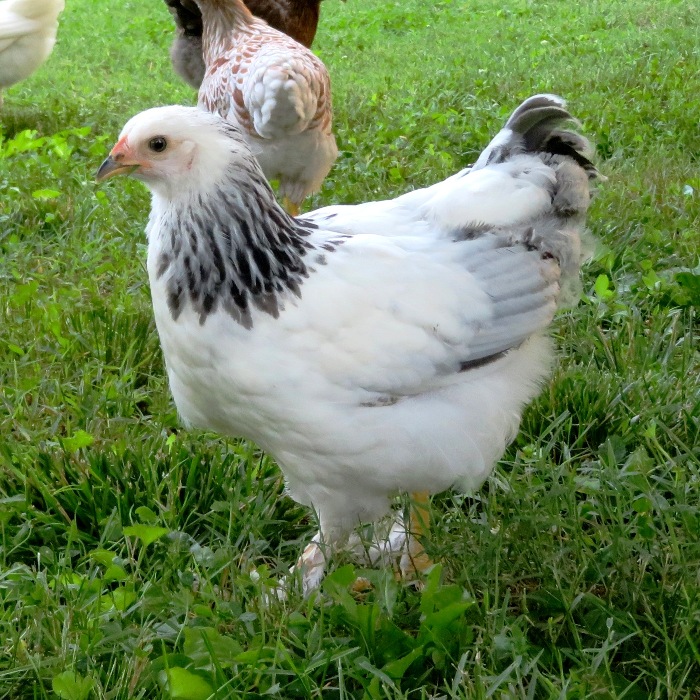
OliviaDate of birth: April 12, 2021Breed: Olive Egger Eggs/Year average: 4-6 dark olive to light teal eggs per week [21] Description: An exciting breed of chickens that typically lay various shades of olive colored eggs. They are created by crossing a dark brown egg layer with a blue egg layer. Meyer Hatchery uses a variety of parent breeds to create several strains of Olive Eggers. Our F1 generation hybrids do typically lay an olive colored egg, however, the olive can be in various shades and the potential does exist to lay eggs of different colors such as tinted, brown, etc. You will be delighted by the varied color patterns of these chicks and their beautiful and plentiful eggs. Average mature weight of hens: 5.5 pounds [21]. Named after Olivia Rose. 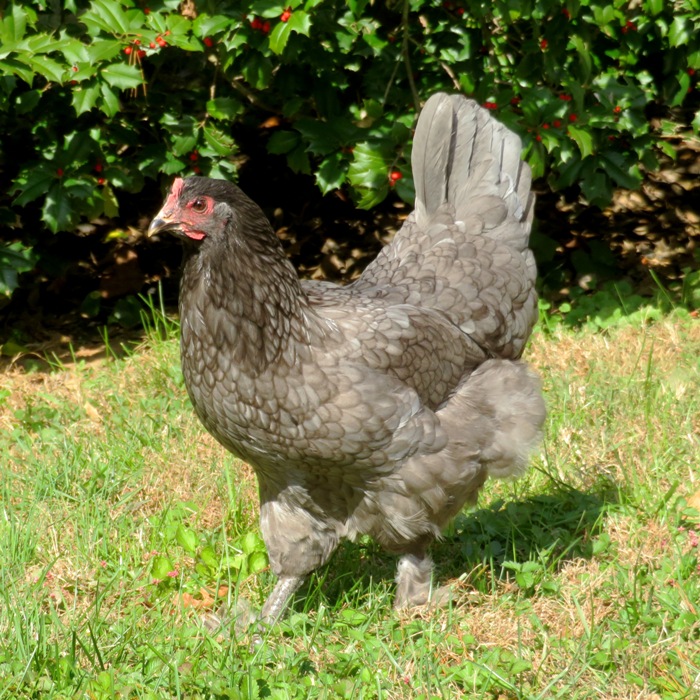
RaeLynn, Rhonda, and RosanneDate of birth: Summer 2021Breed: Rhode Island Red and White Rock mix Eggs/Year average: 300+ large brown eggs [65] Description: The Sex Link Hybrid, also known as Red Star or Red Comet, is the result of crossing two purebred standard breeds: typically a cross between a Rhode Island Red rooster and a White Rock hen. The females are sweet, small and docile, in addition to being wonderful year round layers of large brown eggs, these gals have a great feed conversion ratio. They have red breast feathers and a sprinkling of white feathers over their back. The baby Chicks are color sexed... females are salmon-red color and male are white. This hybrid will regularly produce 300 eggs a year or more [65]. Named after RaeLynn, Rhonda Vincent, and Rosanne Cash. I obtained these hens as pullets. I expected that since they were not raised by me, but rather at what was likely a factory farm, they would not be so tame. I was wrong. 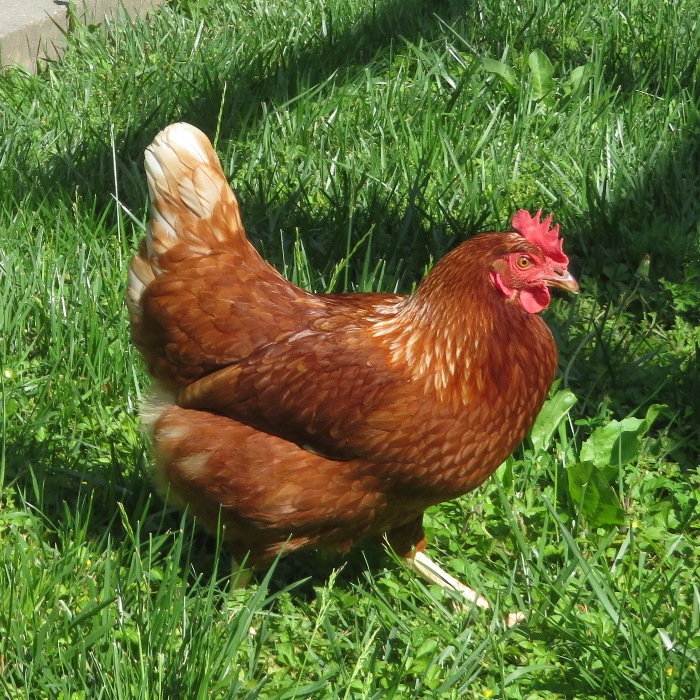
RebaDate of birth: April 12, 2021Breed: Rhode Island Red Eggs/Year average: 200 [57] Description: A popular dual-purpose breed that is a familiar standby in many chicken coops. As the name suggests, this breed was developed in Rhode Island, and is the state's official bird! Rhode Island Red hens are calm and are among the best layers for a heavy breed. Hens are rarely brood, so you'll have to find someone else to sit. Roosters may become aggressive. Males and females are lovely shades of deep mahogany red, are hardy in all climates, and are an excellent free range choice. Rhode Island Reds mature early. Average mature weight of hens: 6.5 pounds [21]. 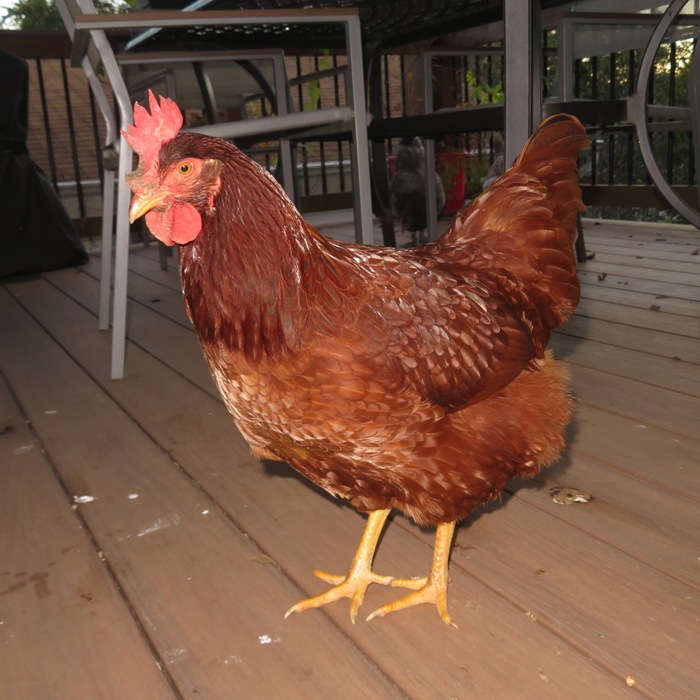
ShaniaDate of birth: April 12, 2021Breed: Salmon Faverolle Eggs/Year average: 3-5 tinted to light brown eggs each week [21] Description: Originally bred by the French for meat and eggs. Faverolles lay a slightly tinted egg and are great layers through the winter. Faverolles are very gentle, do well with children, and can become affectionate with their handlers. Faverolles chickens are characterized by their beards and muffs as well as feathers on their feet and legs. Faverolles also sport a fifth toe! Salmon Faverolles hens have a rounded appearance and are a light salmon brown color with creamy white breast, beard, and muff. Roosters have white neck feathers, a black beard and muff, and a reddish/salmon brown back with black breast, body legs and primary tail and wing feathers. Faverolles are considered to be a threatened breed by the Livestock Conservancy. They are an excellent sustainable heritage breed. Average mature weight of hens: 6.5 pounds [21]. 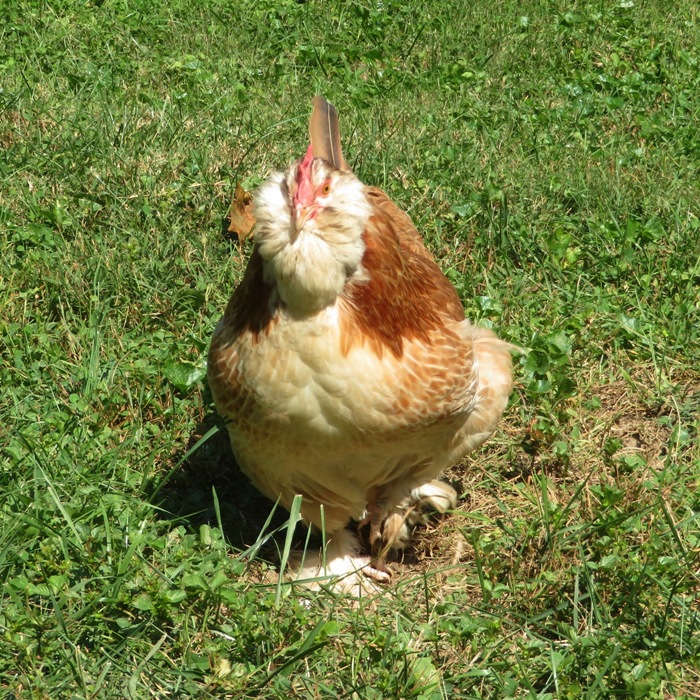
WandaDate of birth: April 12, 2021Breed: White Leghorn Eggs/Year average: Up to 300 or more large white eggs per year or 5+ per week [21] Description: These chickens were developed in Italy and brought to the United States in 1835. They are likely the most popular breed of laying chicken worldwide. Leghorn are very economical because of their high production rate and yet consume small portions of feed. They also mature early, often laying by 20 weeks of age. They are hardy, cold and heat tolerant, non-broody, and are excellent foragers. White Leghorns are a perfect choice for pastured, free-range settings and organic homesteads. White Leghorns have all white feathers, yellow skin and legs, and a single red comb. White Leghorns are very beautiful birds and are often raised for exhibition as well as for their egg laying capabilities. Contrary to belief, there is no nutritional difference in white eggs versus brown or other color eggs. Meyer Hatchery's White Leghorns are considered to be the industrial type. Average mature weight of hens: 4.5 lbs [21]. Named after Wanda Jackson. 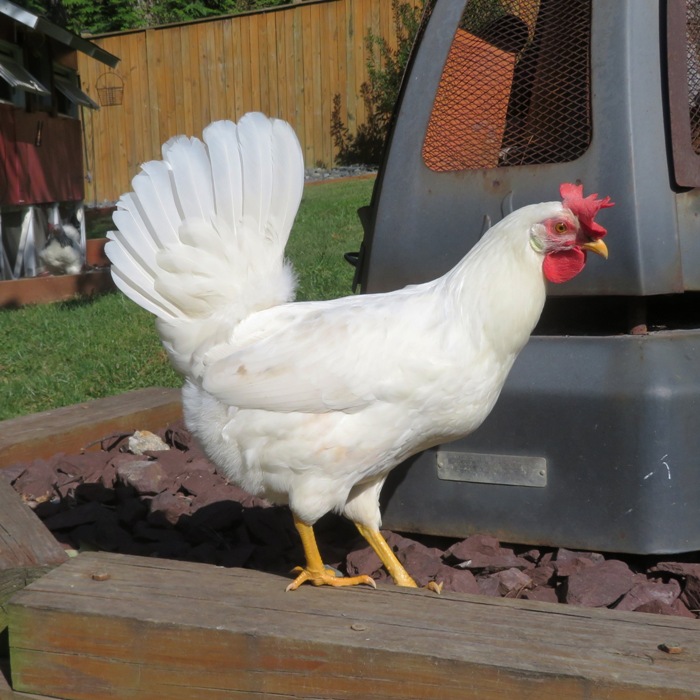
WynonnaDate of birth: April 12, 2021Breed: Welsummer Eggs/Year average: 3-5 brown speckled eggs weekly [21] Description: Welsummers are a rare breed of chicken with Dutch origins, named after the village of Welsum, Holland. They are coveted for the dark reddish-brown speckled eggs. Welsummers are still considered fairly new to North America, imported in the early 1900s. They adapt well to any environment and are excellent foragers. The roosters of this breed are a beautiful sight, and in fact, the rooster you find on the Kellogg's Cornflake cereal box is a Welsummer named Cornelius. The Welsummer egg is especially notable and a favorite for egg baskets. They range in a variety of reddish brown colors from terracotta to mahogany, with varying amounts of brown speckles. No two eggs are alike. Average mature weight of hens: 6.5 pounds [21]. 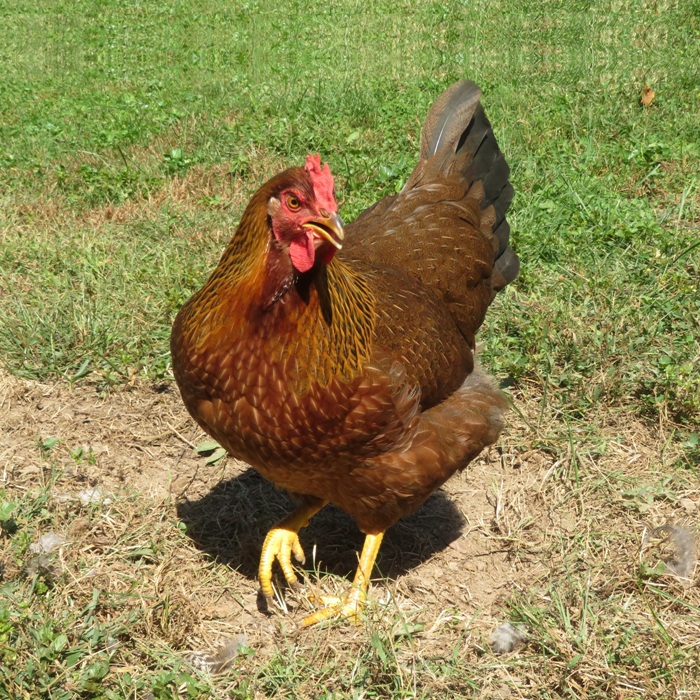
 |

|
On June 2, 2021, I moved them out to the run and coop. At that point, they were living in the coop at night and in the run during the day. Their living space grew at least tenfold as compared to the shower brooder.
In addition to their regular feed, they were eating plants and cicadas, which they love. Unfortunately, they caught the end of the Brood X cicada cycle. It will be a few years before another one that big hits our area again. As of June 7, they still haven't quite gotten used to the idea of going into the coop at night but they are learning. Most go in on their own but I have to go pick up the stragglers and toss them in. I haven't let them free range in the backyard yet. They are still small and I don't trust that our cat would be gentle with them. Here they are on June 5. 
As of June 14, the girls have been outside for 12 days. During this time, they have learned to go into the coop at night and fly up to their perches to roost. But this was their first day out of the run and coop. They got to free range in the backyard for a couple hours. There was plenty of room for them to stretch their wings, go on short flights, eat cicadas and grass, and try to establish a pecking order by facing off with each other. Wynonna, a Welsummer, takes a lower perch. In our last flock, we had a Welsummer but her life was cut short. So we figured it would be good to give this breed another chance. 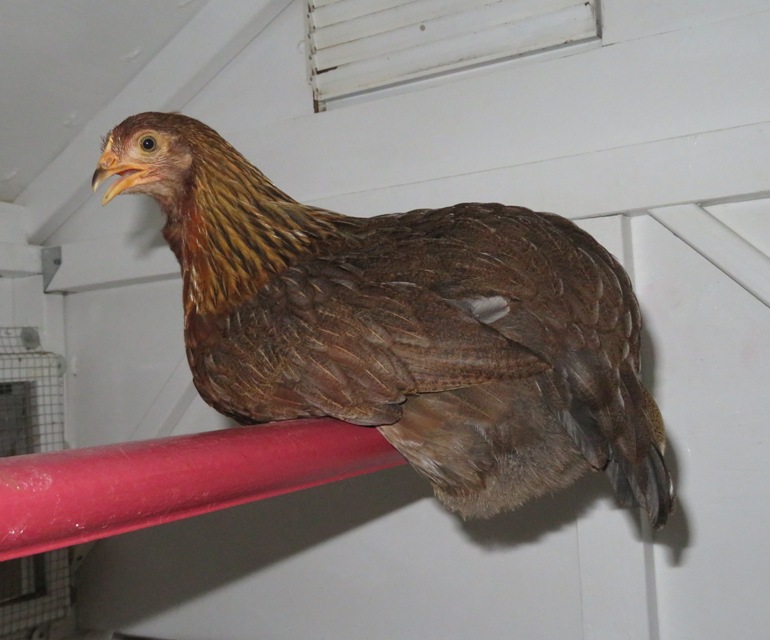
It is hard to get a photo with all the nine chickens and even harder to get one with all their faces. But on June 15, I came close. I was spending a lot of time to get them used to being around me. Wanda would eat out of my hand regularly. The others would venture close but prefer to keep out of reach. I started seeing how music affected them. Banjo music draws their attention. It gets them to lift their heads...something to remember when it comes time to take our Christmas photo. Here are some of them on June 19. From back to front: 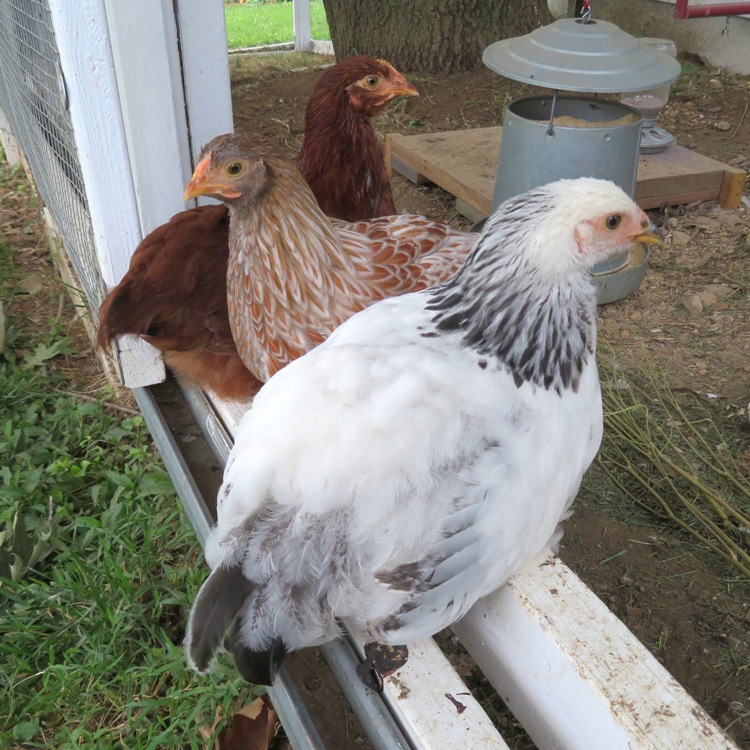
The girls have been establishing their pecking order by facing off with each other. I don't know who the alpha is yet. Only time will tell. As of June 25, about half of them will eat out of my hand but Wanda is still by far the friendliest.  |

|
In mid-July 2021, I drilled a hole into the stump where our white oak was cut down so I could put up a shepherd's hook and hang a disco ball. It isn't meant to be festive. The light that reflects off it is supposedly a deterrent to raptors, so that my chickens can free-range safely. I was told about this from Tim K., who served in my platoon. I found that there are cheaper options such as reflective pinwheels but the disco ball seemed best.
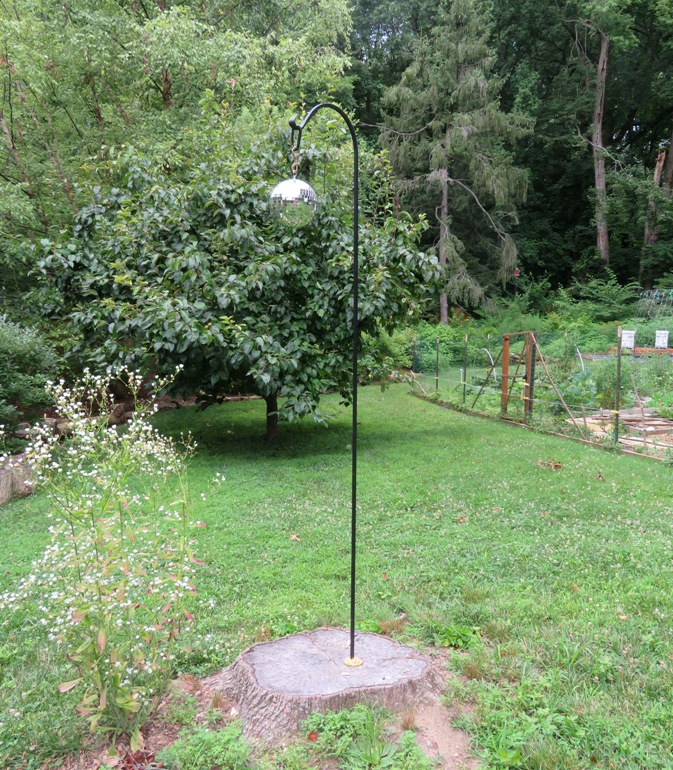
A year and a half after installing the disco balls, I still haven't had any raptor attacks. But I found out in January 2023 that not all raptors were deterred by its presence, even on bright, sunny days. 
Here's the hawk in relation to the chicken run and the disco ball. 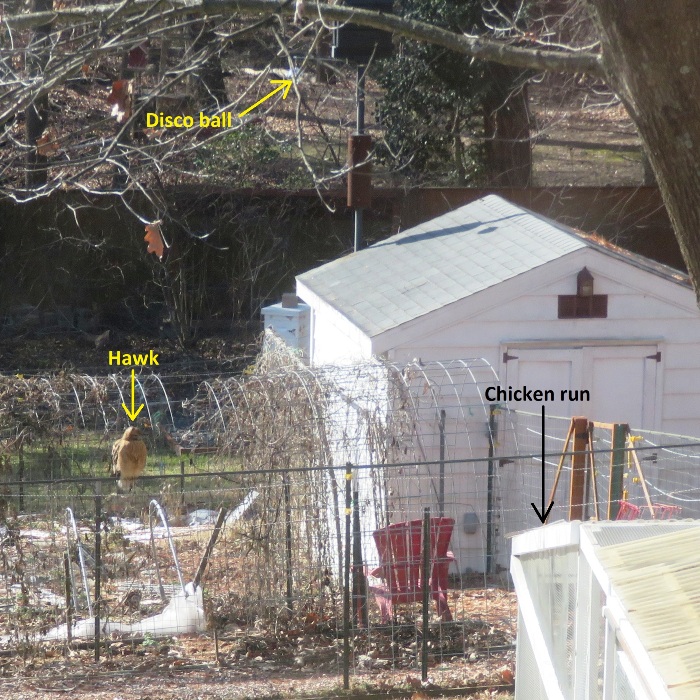
 |

|
On July 25, we let the girls out of the run. Norma saw Chester harass Wanda who then flew over the fence into our neighbor's yard. She was then attacked by their dog. The dog was wanting to play but he is a really big dog and playing for him can be very rough for a chicken. I rushed over to save her. The gate to the fence was locked so I climbed over it and retrieved Wanda. The feathers from the top of her back were ripped off and she had some skin removed. We put her in a dog cage so the other hens could not get to her since they sometimes attack a weak bird and are drawn to blood.
Over the next several days, we kept her in the cage which we put in the house. We didn't want flies to get to her wound and lay eggs. We also felt she would be in a more sterile environment inside the house. We put antibiotic cream on the wound daily and also gave her oral non-prescription antibiotic. I put vitamin supplements in her water to help her regain strength. By July 29, the wound had created a scab. I sprayed it with a liquid bandage containing aluminum. Wanda was released with the rest of her flock that night. I kept an eye on her the next day and she seemed fine. We clipped the feathers on her left wing to keep her from flying over the fence again. Wanda is the smallest of this flock but she is the best layer and her eggs are huge. She is also quite confident and I don't see the other hens pick on her. 
 |

|
Sometime in mid-morning on October 13, 2021, Sara reported that she heard a chicken squawking. The sound carried all the way to her house. She came over and found Reba on the deck, making a lot of fuss. She assumed that Reba had just laid an egg in one of the plant pots. Later that afternoon, Katherine (another neighbor) reported that Olivia was in her backyard. I herded Olivia back into my yard and told Katherine that I would clip her wing so that wouldn't happen again. I was surprised that Olivia flew over the fence...I didn't think she was a good flyer.
That evening, when I closed up the run, I counted only five chickens: Reba, Wanda, Barbara, Crystal, and Olivia. Norma and I checked the yard and found piles of feathers. We found the dead body of Wynonna. It was getting dark. We promised to look more the next day. My first thought was that it was a raptor, but I didn't think a raptor would kill four chickens (they don't hunt in packs) and take the bodies of three. Loretta is really big and I don't think a hawk could carry her off. Wynonna was gone the next morning. Norma checked around and came to the conclusion that it was a fox, especially after reading Hoovers Hatchery - How to Identify Predators: Foxes. There was a fresh hole under the fence in the back right by the brush pile and there were some feathers there. Norma went into the park behind our fence and looked around, but couldn't see anything near the holes that we think were occupied by foxes. But since baby foxes would not likely be living in dens at that time, there would be no reason to find chicken remains there. A few days later, we spoke to our next door neighbor, Sammie. We told her what happened and she said she saw a small fox in her backyard near our property line around the time of the slaughter...a day I now call Black Wednesday. On that day, October 13, 2021, Loretta, Dolly, Shania, and Wynonna perished. Very sad. It was time to up my game so this wouldn't happen again. I started inspecting the area around the fence regularly and putting concrete blocks in places where an animal could fit under. I also began spraying coyote urine on the outside of the fence. I cleared away brush so I could more easily get to the fence. I purchased a Broox Solar Animal Repeller, Ultrasonic Repellent, Motion Detection, and LED Flashing Light. It had great reviews. I set the ultrasonic frequency for fox/dog and then tested it on Daphne. She did indeed hear it but it did not deter her in the least. She simply ignored it. So I sent it back. To discourage raptors, I put up two more disco balls. I figured that at least during the winter (when previous raptor attacks occurred), I would only let the chickens out on sunny days. In December 2022, I set up my game camera because a raccoon had been harassing my bee hives. I ended up catching and relocating the raccoon (see Beekeeping 2022 - Predator: December 2-12). I kept running the game camera even after the hole where the raccoon entered was plugged. A few days later, I saw a fox. The next day, I thoroughly checked the perimeter and found no place under or between the fence that it could have entered. My guess is that it hopped over the fence from my neighbor's property. Their elevation is a few feet higher than ours so it is possible that a nimble fox could have gotten over. Then to leave, it probably jumped on one of our rain boxes to get over the fence and leave. 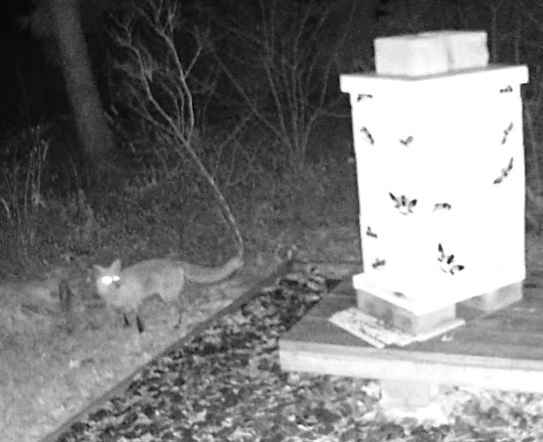
I set out the game camera from December 24, 2022 to January 1, 2023. On December 27, 28, and 30, a fox visited the hives and on December 31, a racoon visited.  |

|
By December 20, 2021, all five of my remaining girls were laying.
A little before Christmas, Reba flew over the fence. So Norma and I clipped the left wings of everyone except Wanda, whose left wing had been clipped earlier in the year. But a few days later, Wanda also flew over the fence. So she got her left wing re-clipped. I decided to purchase pullets to replace the hens that were taken by the fox. But pullets are hard to find in the autumn. After talking to my sister-in-law, she said she could get them from Southern States in Garrett County. So Norma and I ordered three. Her sister picked them up for us along with the ones she ordered for herself. Their breed is Red Comet, which is a hybrid of Rhode Island Red and White Rock. Keeping with the naming algorithm for the third generation, I named them RaeLynn (a modern country music singer), Rhonda (after bluegrass singer Rhonda Vincent), and Rosanne (after Rosanne Cash). I picked them up on December 26, 2021. I put them in Daphne's old dog crate and then drove home. The car smelt like chicken poop for the entire 3.5 hour drive. But it was well worth it. I introduced the rookies at night. They were about the same size as the veterans. As far as I know, they were getting along well enough. The rookies didn't seem interested in sleeping on the roost. Instead, they slept on the pine shavings under the others. That means they were likely getting shit on. The three new chickens stuck together, even several months after I integrated them into the flock. As far as I know, they were not picked on and seemed to mix well. Unlike the other girls, which are different breeds, these three Red Comets look the same to me. So rather than try to call them by their individual names, I simply refer to them as the three 'R's. I expected that pullets would not be well socialized for being around humans since they were likely raised en masse. In contrast, my girls were raised by me since they were young chicks, and they saw me daily. But I was wrong. The three 'R's were as comfortable around me as my veterans. 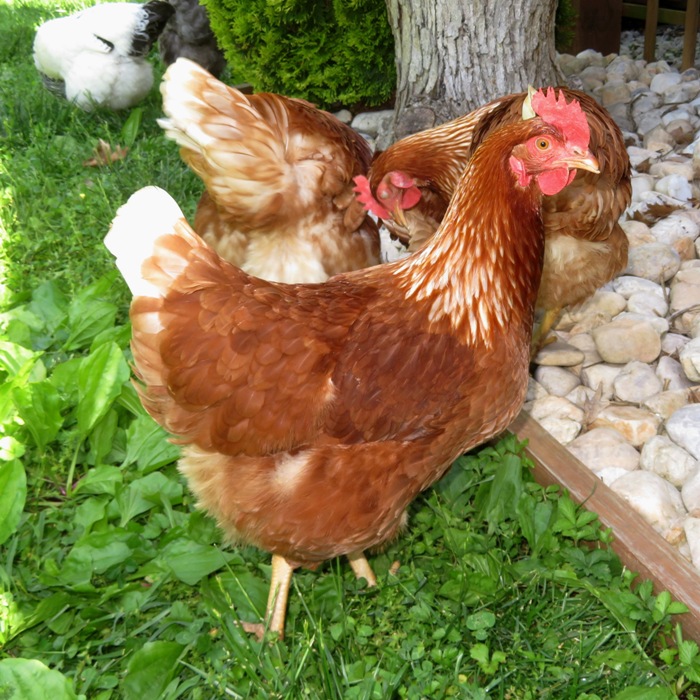
One thing about the three 'R's that I find funny and strange is the way that they squat down when I approach them. This is a common trait among may laying hens. This is how they signal to roosters that they are receptive to mating. But what makes my three 'R's unique is that when they squat, they also stomp their feet. They do so very hard and sometimes dust will fly up.  |

|
In the winter of 2021-2022, I had a problem with rats getting into the run so they could eat the chicken feed. This prompted me to put a lot of time and money into upgrading things to Chicken Run Version 3.1.
In May 2022, I installed over 100 feet of Dig Defence Large Animal Barrier to prevent predators from digging under our privacy fence. Our home is becoming more and more like Fort Knox with the chickens being the gold. 
As of June, we have not had any raptor attacks since I installed the disco balls. So they seem to be working. In December 2022, I found that a raccoon dug under the animal barrier. How do I know it was a raccoon? Because I caught it. See Beekeeping 2022 - Predator: December 2-12. 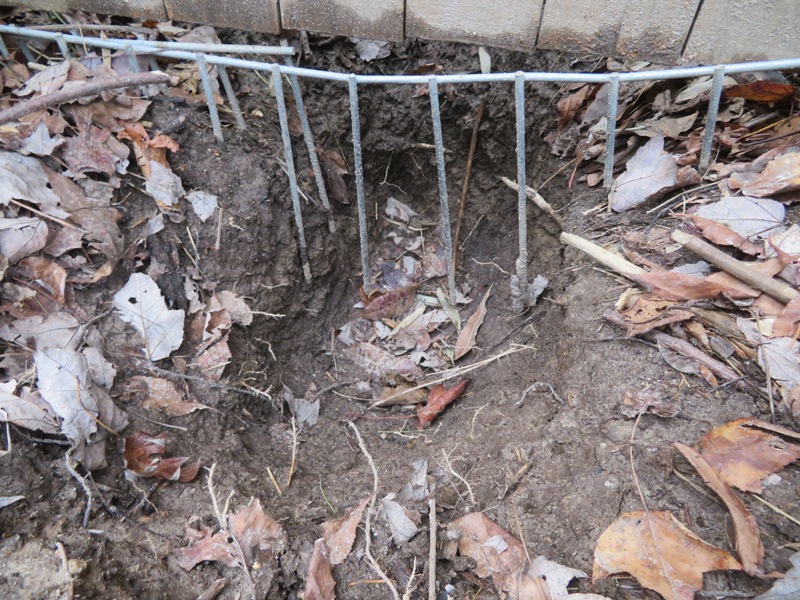
I plugged up the hole with cinder blocks. After I relocated the raccoon, nothing tried to dig in that spot.  |

|
As of spring 2022, I feel like this flock is the best layers I've ever had. They typically produce six or seven eggs a day! Wanda is the true power layer. How such a small bird lays such big eggs I'll never know. Hers are the only white eggs so they look exotic compared to all the brown eggs but I know that in the grocery store, hers would be the norm.
I can't eat all the eggs that they lay so I sell some for $4 a dozen. I also give aways a lot. In my new job, I was raffling them off with the condition that the same person couldn't win the raffle more than once. Then I put together weekly contests and the winner would receive eggs. These contests were generally word problems that test one's knowledge of the English language.  |

|
Around April 2022, Olivia went broody. So my "best layer" flock was down one participant. In early May, Barbara also went broody. Not good. It is pretty rare for me to have two chickens that are broody at the same time.
These two hens are quite a bit different. Olivia is lightweight or average and of moderate temperment. In contrast, Barbara is heavy and will sometimes peck me if I try to lift her out of her nesting box. I think Barbara (shown below) is my prettiest hen because of the color pattern on her feathers. 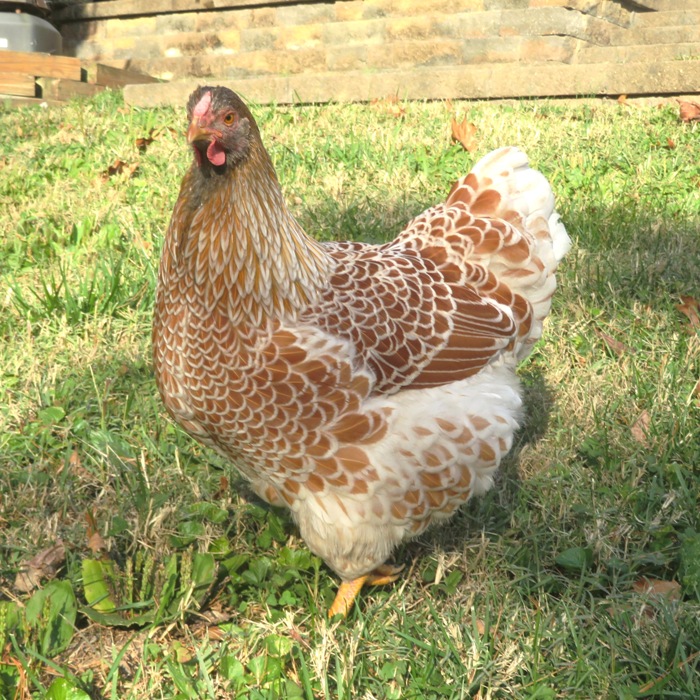
In June 2022, Olivia stopped being Broody but then Crystal started up shortly after. But then Olivia started back a few weeks later and Crystal stopped. Olivia is normally a terrible layer but her winter production is pretty good and her eggs are a deep brown, like chocolate. Barbara went broody again in December 2022. 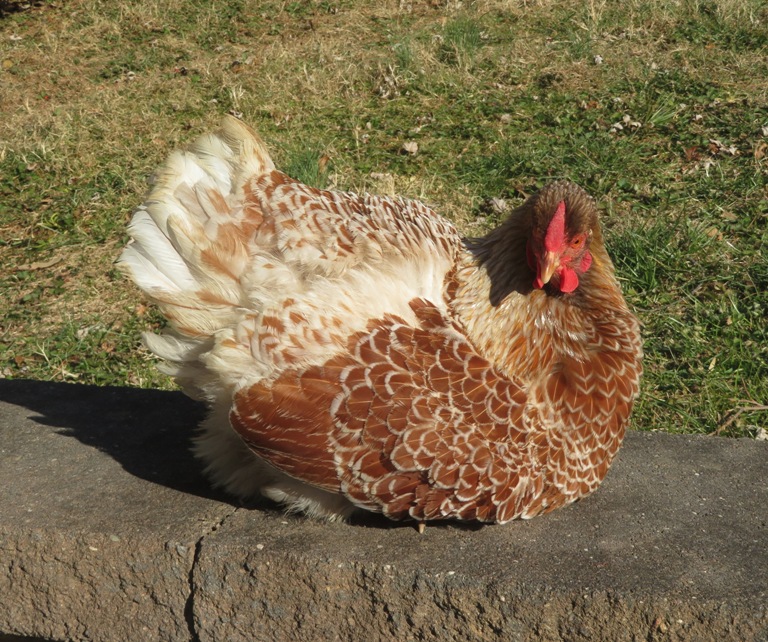
 |

|
Chicken photography is very difficult. The more chickens you have, the more difficult it gets. I've given up trying to get them to look at the camera. Just the fact that they are in the shot is often sufficient. Here is a snapshot from when we did our Christmas photo on October 15, 2022. All eight can be seem but not easily. Can you find them all?
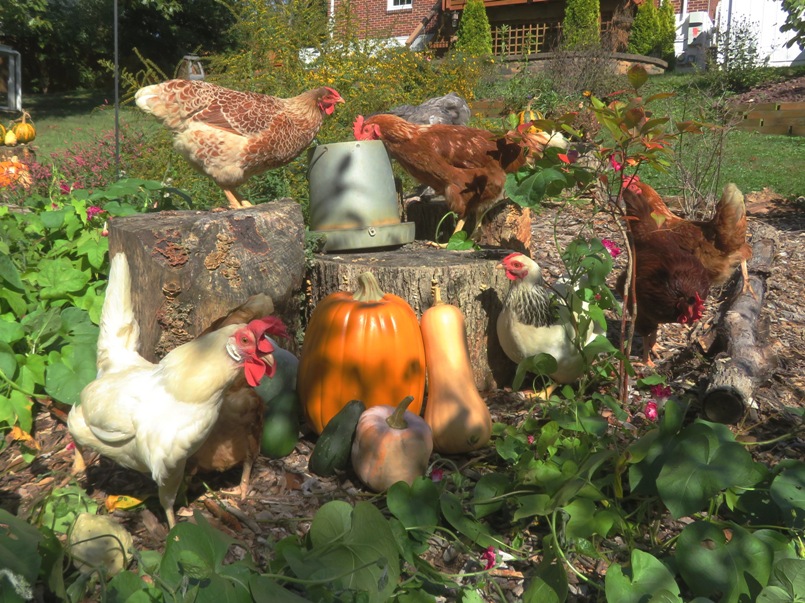
 |

|
On May 4, 2023, I found what I believe was a wild songbird egg. It had fallen out of a nest that I was unable to find. With Barbara being broody and wanting to be a mother, I thought it would be neat if I could get her to hatch the egg. So I put it under her. Visions of Horton Hatches the Egg passed through my mind. Unfortunately, Barbara's weight ended up breaking the egg.
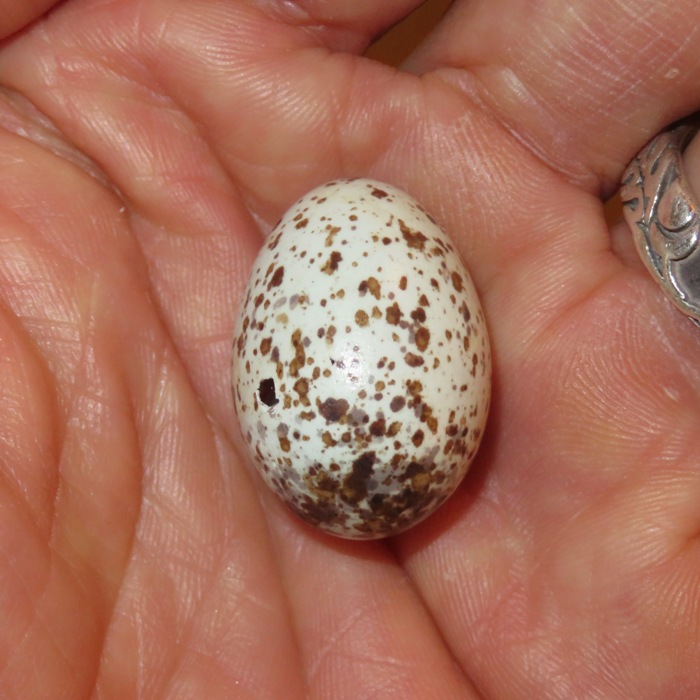
 |

|
One chicken is dead and another is injured.
My chickens have two layers of defense: a coop door and a chicken run. Assuming the two of them are shut, a predator has to go through both to get to my hens at night. Over the weekend, a raccoon squeezed through the gap between the oak tree and the hardware cloth roof of the run. There has always been a small gap to give the tree room to grow, but this is the first time in eight years that a predator has squeezed through. Then it broke the plexiglass door to the coop and attacked my chickens. 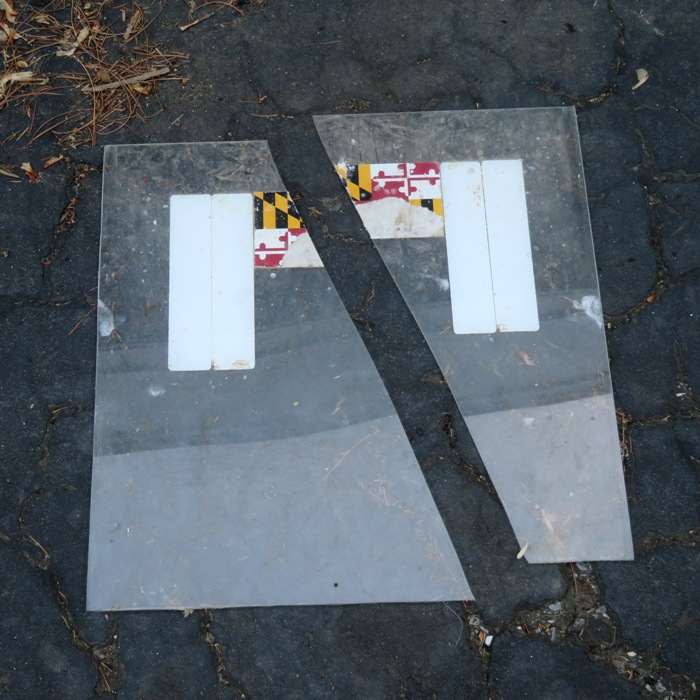
I caught the raccoon on May 15, 2023 with a Hav-a-hart trap and then released it four miles away on the other side of a busy road in a wooded area. Click the below image to play a video. Here is the culprit. 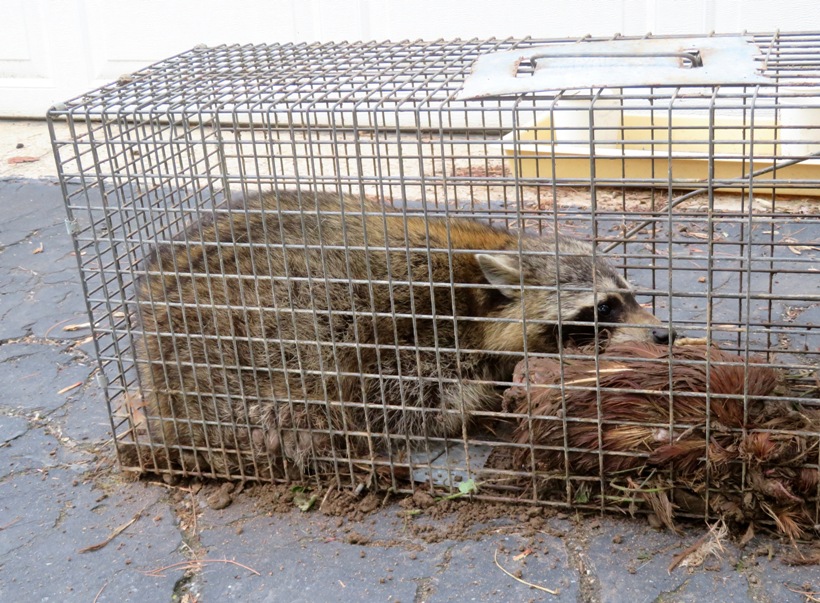
Next, I replaced the coop door with a metal one. 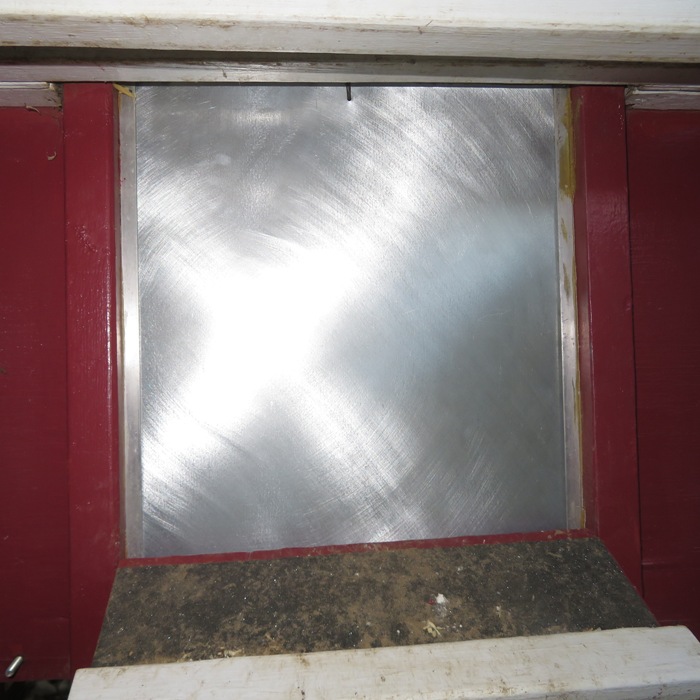
I also made the gap around the tree significantly smaller and reinforced the area around the gap with wood to make the hardware cloth more rigid. 
The raccoon decapitated one of the three red comets that I purchased from Laah as a pullet. Her name was RaeLynn, Rhonda, or Rosanne...I could never tell them apart so I just called them the three 'R's. Now they are down to two. I used her dead body to bait the trap and catch the predator so you could say that her sacrifice helped protect the rest of the flock. Barbara (named after Barbara Mandrell) was also injured. She was a blue laced red wyandotte that I raised as a chick. She has various wounds which I treated, and so far, it looks like she will pull through.  |

|
On May 18, 2023, a fox killed Crystal, our Columbian Wyandotte, named after Crystal Gayle. Her breed was first introduced at the Columbian Exposition (better known as the World's Fair held in Chicago) in 1893, hence the name they now hold.
I was not home at the time of the attack but Norma verified that it was a brazen red fox that came into our backyard in broad daylight and killed Crystal while the girls were out free-ranging. Norma was able to scare it off before it took the body. Later that night, I baited a trap with Crystal's body. In the morning, the trap was sprung, Crystal was gone, and no fox was caught. Over the years, we've caught about seventeen groundhogs, six raccoons, squirrels, and rats,...but never a fox. They really are quite clever. The coop and run are secure so they are safe in there but outside of that, they are vulnerable, despite our privacy fence. We've not been letting them free-range unless one of us is out there in the backyard or close by. I am down to six.  |

|
In early June 2023, Reba got sick. She wouldn't go into the coop at night and seemed lethargic. Her breathing didn't seem labored and there were no signs of trauma. We isolated her and then gave her some Tylan 50 antibiotic but she perished shortly after. I have to wonder if she knew she was sick and didn't want to infect the rest of the flock so she chose not to go into the coop when the others did. Weeks later and the others are all fine. Down to five.
|

|
On October 11, 2023, I let the chickens out once I got home from work. I'd been limiting their time outside to when there is more activity in town, thinking that predators would be more likely to stay away. But instead, a brazen fox came into out back yard and killed three chickens before we could chase it off. I used two of the dead bodies to bait traps for it. It returned that night, took one chicken without springing the trap, and sprung the other trap without being caught. Despite catching numerous groundhogs and raccoons, foxes have always managed to outsmart me. Perhaps this is why Japanese folklore considers them supernatural creatures capable of metamorphosis.
Casualties include Barbara, Rhonda, and Wanda...the latter being our favorite. Shown below are the last two survivors from my 2021 flock: Olivia and Rosanne. 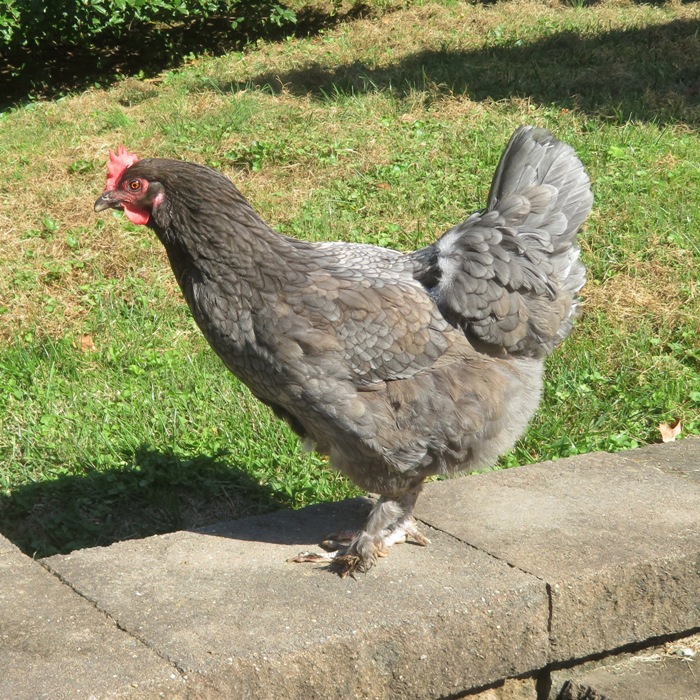
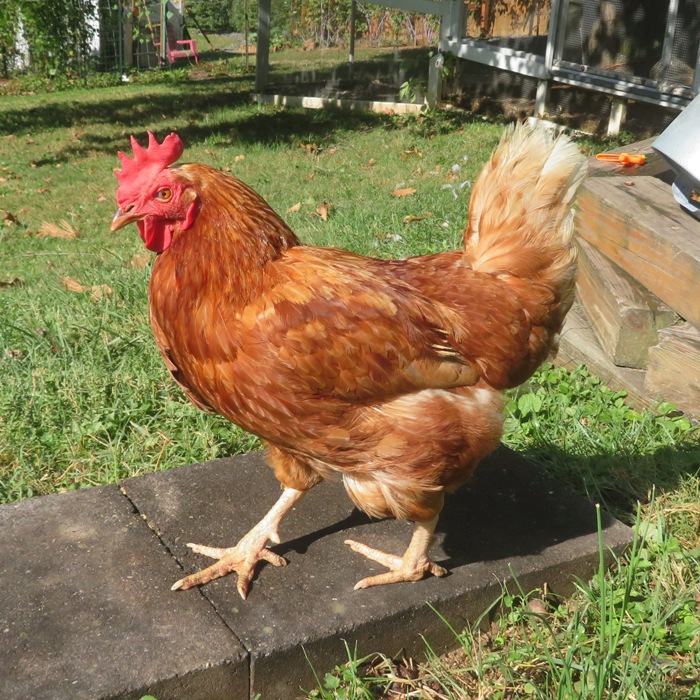
|